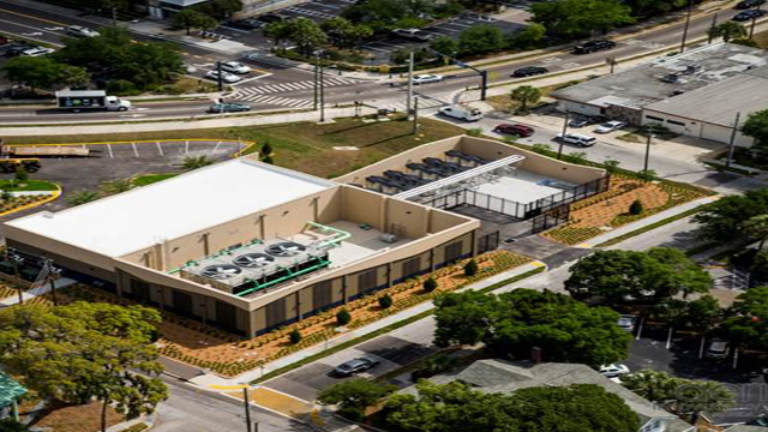
Challenge
HVAC equipment in seven Pinellas County government buildings was inefficient and reaching the end of its useful life. The county wished to upgrade the systems to improve energy efficiency and reduce operational costs, without compromising service to its building occupants. With much of the obsolete equipment located in building basements, the county knew that replacing it would be a challenge.
Solution
Trane responded to the county’s request for proposal (RFP) with a creative solution to keep the 700,000 sq ft of government office space comfortable, using a downtown district cooling, central plant design rather than operating seven individual building systems. The Central Energy Plant (CEP) would include pre-insulated steel piping, three Trane® centrifugal chillers, thermal storage using twenty-one CALMAC® IceBank® energy storage tanks, massive cooling towers and a Trane® Tracer™ SC building automation system.
The CEP would accommodate future expansion and afforded the county the opportunity to sell chilled water to neighboring entities as a continuous service or a stand-by emergency connection. The CEP offered the county a multitude of benefits, including operational economies of scale, energy savings, a reduced carbon footprint, lower maintenance costs, and elimination of the expense of replacing equipment located in building basements. After careful evaluation, the county made the decision to move forward with the CEP, and based on projected energy savings, was able to obtain a grant from the US Department of Energy to help fund the project.
Building the infrastructure
To connect the government buildings to the central plant, a piping network, consisting of 6,700 feet of large diameter, pre-insulated steel pipes, was buried under the streets of Clearwater. The piping delivers chilled water to provide low-cost air conditioning for the buildings. A fifty-year life expectancy on the pipes eliminates any near-term need to tear up the city's streets for replacement.
Improving efficiency, reducing energy costs
Water that is cooled by two 650-ton Trane® CenTraVac™ centrifugal chillers is pumped through underground pipes to air-conditioning units in downtown buildings. The multi-stage chillers offer full-load efficency levels averaging 15 percent better than competitive chillers, and with the industry’s fewest moving parts, provide reliable operation. The CenTraVac™ chillers also meet the city’s environmental standards with the use of low-pressure refrigerants and a near zero leakage rate. The chillers' quiet, vibration-free operation keeps sound levels below those mandated by city ordinance.
A 470-ton Trane® CenTraVac™ chiller makes ice for twenty-one CALMAC® IceBank® energy storage tanks. The ice is produced at night when electricity rates are lower, and is then used during the day to cool water being pumped to the downtown buildings. The system allows the chillers and cooling towers to sit idle during the more-costly, daytime peak hours, helping to reduce energy costs.
Optimizing system operations
The CEP uses a Trane® Tracer™ SC building automation system (BAS) to allow operators to access plant systems from any web connected device, such as a smart phone or tablet, eliminating the need to have on-site personnel at the plant. Plant managers use the BAS to set up scheduling, monitor operating conditions and tonnage, manage energy usage, address alarms, and analyze data. The Tracer Chiller Plant Control application enables chiller sequencing and the coordination of pumps and chiller towers for overall plant efficiency.
Results
The new Pinellas County Central Energy Plant pipes water to provide low-cost air conditioning to five county buildings and nearby high-rise apartments. The plant is expected to save the county approximately $1 million in operating costs, mostly from reduced energy usage. With annual kilowatt usage dropping 30 to 40 percent, the county will reduce its carbon footprint by approximately 25 percent, and qualifies for rebates from Duke Energy. The county will not need to replace chilled water system components during the plant’s 30-year life expectancy, which equates to approximately $4 million in cost avoidance. The county also aims to generate revenue from the plant with nearby businesses expressing interest in purchasing chilled water for their air conditioning systems. Revenue generating opportunities are estimated to be approximately $250,000 per year.
